A few weeks ago, I made a mistake.
When Vizkopa Guildmage was spoiled, I knew that people would want to build around the infinite combo it has with Exquisite Blood. While I suspected that the pairing might not see play in competitive Standard events, my eye was already on the Avacyn Restored rare as a long-term casual hit. I figured the issue was about to be forced, so I logged on to StarCityGames.com in order to buy them out.
News of the combo had already broken on Twitter, so I had just seconds to act. SCG had fifteen or so regular copies available for $0.99 each and fourteen foil copies available for $2.49. “This is a casual card,” I thought to myself, “so the foil could jump to three or four times retail.” 30 seconds later, all the foils were mine. At this point, the regular copies had sold out as well, and my chance to act had ended.
Today, the spread looks like this:

Based on retail pricing, normal copies of Exquisite Blood have jumped to four times what they had previously sold for. Taking a quick look at eBay completed listings, I would have made about $7 per playset after postage and fees were I to sell them today.
Foil copies of the card only jumped to about three times the original price. Even though I would have theoretically made more money were I able to sell all of the cards at retail, such things are not feasible for private speculators without a physical or online storefront. Only one set of foils has sold on eBay since the price jump, and if that sale had been mine it would have netted me a $10 profit. Even though that is a larger return, it required a much greater initial investment—$10 to make $10 instead of $4 to make $7. In addition, foils take longer to sell, and the number of prospective buyers is much lower.
Of course, foils sometimes behave in the exact opposite way. Check out this card:
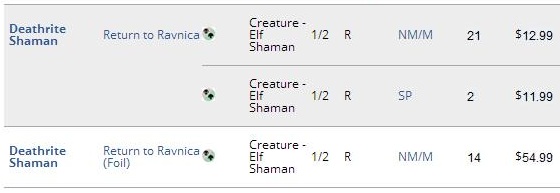
Or this one:
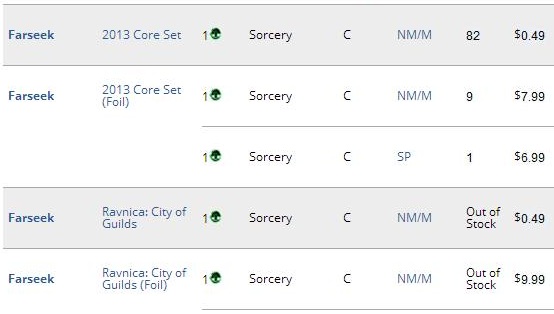
Weird, huh? I think it’s time to talk a little more about foils.
The Philosophy of Foiling
Why do people foil out their decks? Generally, it’s due to one or more of the following reasons:
- Foils look awesome. They’re shiny and pretty and rare.
- Searching for foils is great fun. Going binder-to-binder looking for that one rare card is like a treasure hunt.
- Foiling out a favorite deck is a great way to connect with it and make it “yours.”
- The bragging rights can be kind of a big deal. Foiling out a deck is both difficult and expensive. Doing it represents a serious achievement.
- The intimidation factor. Having a foiled-out deck represents a serious commitment to a deck, which generally implies some level of mastery. If I’m playing against an all-foil Elves combo deck at a Grand Prix, I’m going to assume my opponent knows that particular build very well.
I spent years traveling to events and making trades in order to foil out my cube. I did it for many of the reasons above—I love the way foils look, I love going on treasure hunts, and I wanted a way to forge a deeper connection with my cards. Most of my collection comes and goes depending on which way the prices trend, but my cube will be with me forever. Building it synthesized my loves of trading, deckbuilding, and collecting into one singular pursuit.
Similar sentiment is a large part of why Vintage and Legacy foils tend to hold the most value. People who play Eternal formats often have favorite decks that they have played with and treasured for years. Many times, foiling out these decks (or otherwise pimping them out with foreign or Beta cards) is the best way for players to put a personal stamp on their builds. It also feels weird to play a 50 cent bulk rare next to a 500 dollar Mox.
Because of this, the most valuable foils are Legacy and Vintage staples. The cards that fit in multiple decks tend to be the most desirable because the demand is higher.

Foils that see Legacy play but only in fringe decks don’t command the same premium. Many of these cards only have the normal 2x foil modifier.
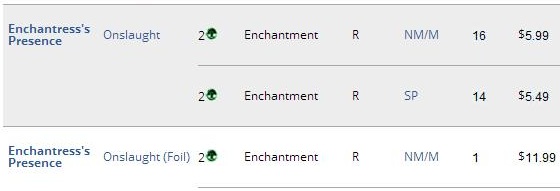
Of course, things are different on the trading floor. A foil like Enchantress’s Presence isn’t going to interest the vast majority of traders at any price. The one person who needs it, however, will likely be willing to give up a lot to make the deal happen.
Everything goes out the window when it comes to foreign foils. Visara the Dreadful is another Onslaught rare that sells for around the same amount in foil on SCG that Enchantress’s Presence does—$13 instead of $12. But take a look at the difference in price between the Japanese foil copies:
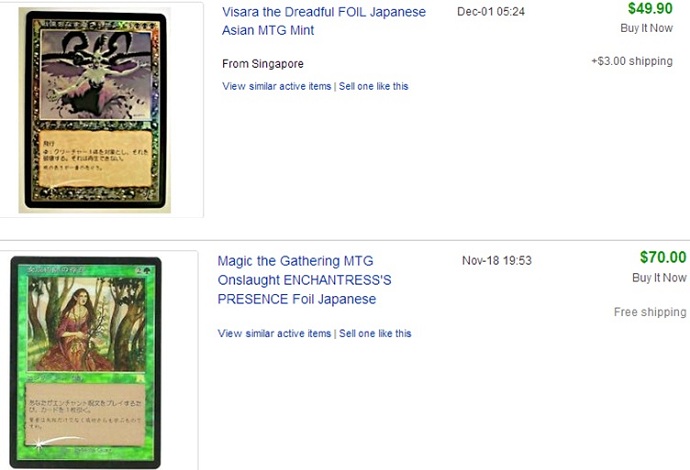
$20 might not seem like the biggest difference in the world, but it can be the margin between a good trade and a great one. When evaluating Japanese foils, I generally go by the following two rules:
1) Legacy cards and legendary creatures are always worth acquiring.
2) They are always worth more than you think.
Foils in other foreign languages are worth a lot too. The most expensive foreign foils on SCG right now? SP German foil Tarmogoyf at $550, MP Japanese foil Wooded Foothills at $450, and SP German Foil Polluted Delta at $400. When dealing with the rarest and most desirable Legacy staples, any unique identifier—a foreign language or a cool misprint—can ratchet the value into the stratosphere.
The most surprising cards over $200? That’d be a SP Russian foil Trygon Predator at $225, NM Japanese foil Future Sight at $200, and a NM Japanese foil Merchant Scroll at $350.
Which languages are the most valuable in foil? I couldn’t find a single card on SCG with enough data to make for a compelling case study, so I had to jump on eBay and check out some completed listings.
I could only use examples from M12 onward because that is when Korean cards were reintroduced—there were no foil Korean cards from any set before that. (Korean also ran from Fourth Edition through Urza’s Saga in the pre-foil era.) Russian cards did not exist until Ninth Edition.
With the exception of Chinese, foreign cards that do not use the Latin alphabet are worth more than languages that do. Russian, Japanese, and Korean are far more desirable than French, Spanish, etc. This is due primarily to aesthetics—to someone who doesn’t speak one of those languages, the foreign script looks like part of the art of the card.
But which of those languages is at the top of the heap? Let’s use a card popular in Legacy, Modern, and Standard alike: Snapcaster Mage. First, let’s snag a baseline by taking a look at what the average English foil Snapcaster Mage sells for these days.
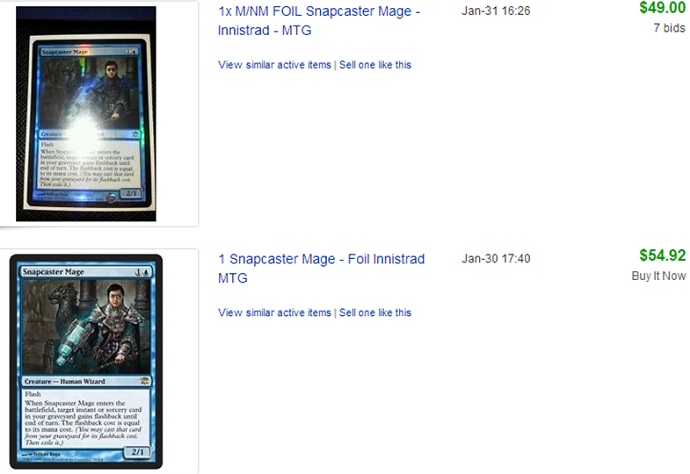
Okay, not bad. Through a little bit of research, it looks like English foil copies of this card regularly close to just over $50.

Chinese cards tend to have the lowest foil premium of any foreign language. This is because eBay sellers in China will buy cases and cases of product to crack and sell as cheap singles, saturating the international market. Chinese copies of non-foil cards tend to only be worth 70% or so as much as English copies. With causal cards, it can be even lower.
What about Japanese, the most commonly desirable foreign language?

A lot of auctions were closing in the $160 range, so this is a pretty established price point. In the case of Snapcaster Mage, Japanese foils are worth more than three times as much as English ones. That’s a major premium!
How about Korean?

Several other Korean copies were posted at a $400 Buy-It-Now, but this is the only sale that went through. With a Buy-It-Now, it’s possible the “true: price for a Korean foil Snapcaster is closer to $300.
Is that the top of the heap? Not quite:

Good gravy! Just by switching the language, we’ve jumped the foil price of this card 900 PERCENT. Maybe it’s time to start exclusively buying foreign boxes of product?
On other cards, the difference between Korean and Russian is less pronounced. Check out Geist of Saint Traft and Huntmaster of the Fells:
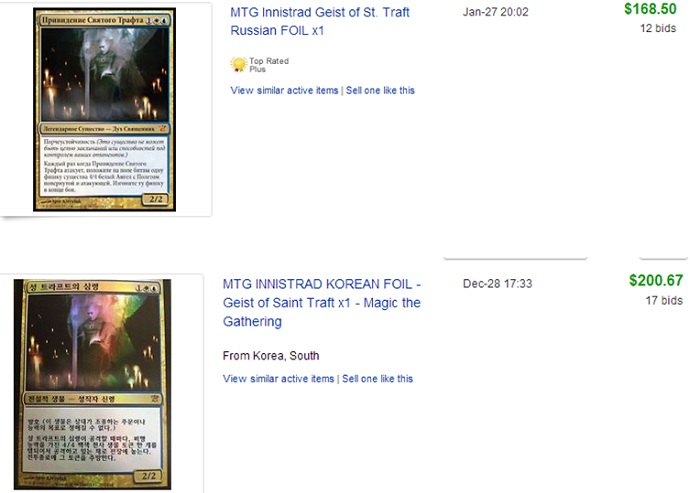
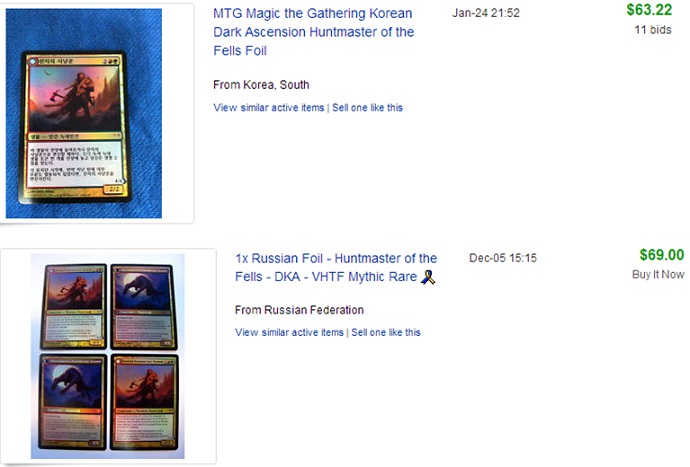
The biggest takeaway is that the foreign foil card market is erratic. Enter at your own risk—there’s a lot of money in it if you know what you’re doing, but making proper trades requires some on-the-spot research. If you’re trading up to a foreign foil, make sure you’re not giving up too much for a premium that doesn’t exist.
If you’re trading away a foreign foil, especially a Japanese one, always look it up before you agree to a deal. Sometimes, unexpected cards can be worth big bucks.

After enough years have passed, the printed rarity on a card is almost irrelevant. Until very recently, the large sets were so huge that opening a foil copy of any specific common was akin to opening a foil rare in a pack of a newer expansion. When you add that to the time that has elapsed since most of these sets were current, you end up with a group of cards that are very difficult to find.
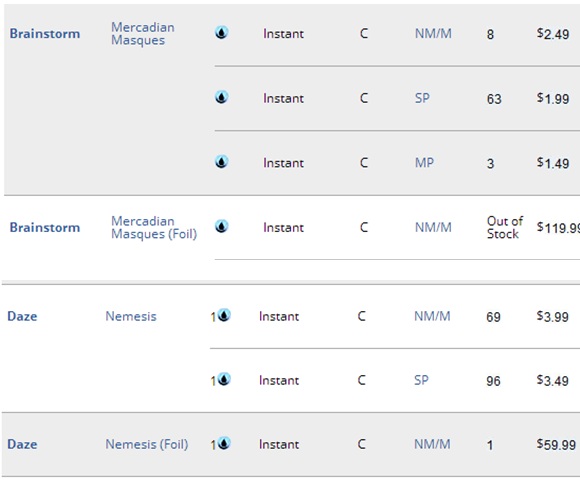
Why is a $4 card like Daze worth $60 in foil? Think about it from the point of view of someone trying to foil out their Legacy deck. Daze might be a common, but foil copies of this are still far harder to find than most foil mythics today.
This sort of premium can show up from time to time on commons and uncommons in Standard as well. In general, the card has to be a crossover hit—the sort of creature or spell that could see some play in Legacy, Modern, and/or casual formats as well as Standard.

Cards with less crossover potential tend to have less extreme foil values, even if they see just as much (or more) play in Standard.

In general, Standard foils command only a small premium compared to Legacy and Vintage cards. This is because the format rotates quickly and the metagame changes all the time, so maintaining a full tricked-out deck is almost impossible. Because of that, the foil prices on hot Standard cards are often double (or just under) the price of the normal version.
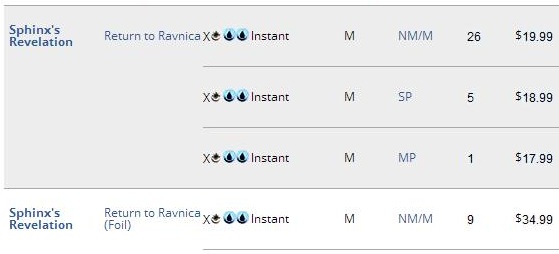
Of course, this changes when a card is also excellent in a foil-centric format like Commander. Consider Angel of Serenity. The card is from the same set as Sphinx’s Revelation. Both are mythic rares. Revelation is twice as expensive as Angel, though, because of how much more play it sees in Standard. Check this out, though:
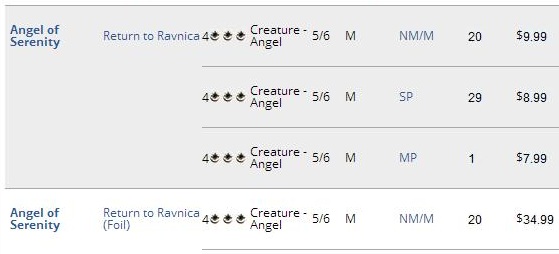
Thanks to Commander and the popularity of Angels in general, both foils sell for the same amount.
Even though it might seem like casual demand might drive the price of foils, a distinction needs to be made between Commander and the 60-card kitchen table variants. Here are the prices on a few cards that are played almost exclusively in Commander:
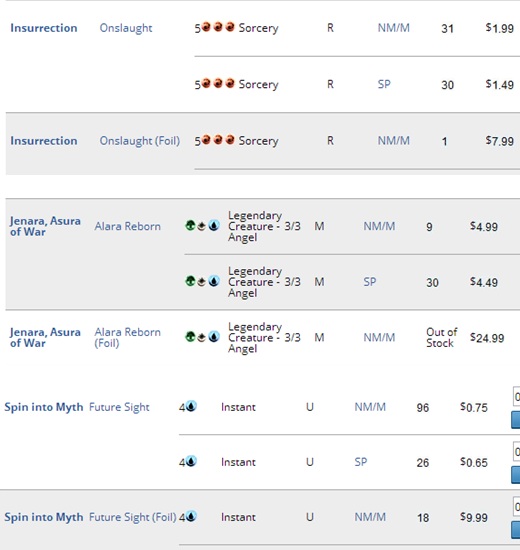
Compare that to some of the 60-card casual staples:
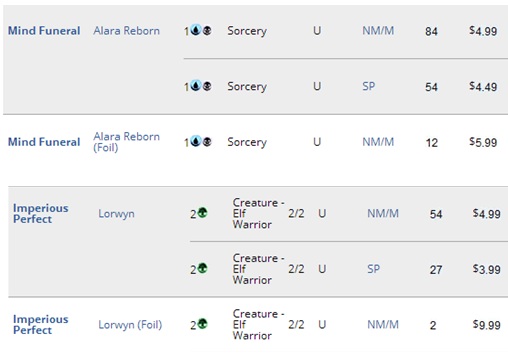
Most Commander players have been part of the greater competitive Magic community at one point or another. The format was started by judges, and it caught on with the sort of players who get frustrated by quickly rotating formats, enjoy personal expression, like collecting, or want to play a splashier, more casual game of Magic.
Not coincidentally, this demographic overlaps considerably with the sort of people who enjoy foil cards.
True casual players tend to be outside the competitive community entirely. They were never in it to begin with. These players don’t think about the possibility of foiling out an entire deck. Most of them see no reason to spend extra money on a card just because it’s shiny, so they don’t.
Why do so many traders wrongfully assume that this group of casual players drives the price of foils? My best guess is that it has to do with how hard it is to trade for foils from them.
Even though casual players rarely buy foil cards, opening a good one in a pack is a triumph for them. If they don’t have a deck for it, it’ll end up in a spot of honor in the front of their trade binder. This doesn’t mean it’s for trade—just that they want to look at it and talk about it a lot. This leads many traders to (rightly) assume that casual players value foils very highly and (wrongly) assume that they will give up an arm and a leg to get more of them.
This seems counterintuitive, but it’s really not. Imagine for a moment that you have just won a beautiful 60-inch state-of-the-art LCD television set in a sweepstakes draw. Chances are that you’d plant that sucker in a spot of honor in your living room. Unless you were really hard up for cash, you probably wouldn’t sell it and sock the money away—you’d be thrilled to have something far nicer than you could otherwise afford.
At the same time, the enjoyment of owning that TV isn’t going to change your spending habits. You’re probably not going to go out and buy a second one for your bedroom or empty your savings and put a down payment on a yacht. This is roughly how casual players view foils.
Foil reprints generally hurt the value of set foils. Consider Aether Vial:
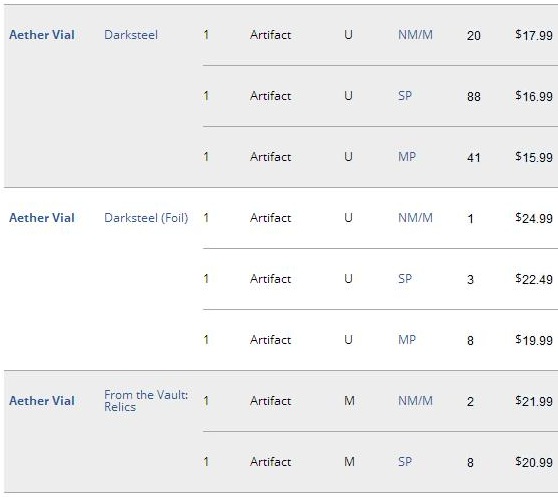
Even though the set foil is the most expensive and desirable version of Aether Vial, it was worth about twice as much before the promo was released.
Before From the Vault: Relics, cube builders and foil hounds only had one opportunity to get a premium version of the card. Now, there is an easily available alternative.
Original printings of foils tend to be worth more than reprints. This is especially true when the earliest printing of a card had the old frame. A Legions foil copy of Akroma, Angel of Wrath, for example, sells for $30 on SCG. The Time Spiral foil is just $16.
This is taken to an extreme with a card like Birds of Paradise. Seventh Edition foils are amazingly rare—it was the first base set with foil cards, the only base set to be foiled with the original card frame, and only foils from that set had a black border. It was a very large set, too—specific foils are few and far between.
Because of all that, Seventh Edition foil Birds of Paradise—the first foil copy and the only one with the old border—sell for $100 and up. Even cards like Meekstone and Serra Angel retail for $40 in Seventh Edition foil. Goblin Matron is a $100 uncommon in foil.
From Urza’s Legacy through (I believe) Judgment, it was possible to get a foil with a cutline on it. Cutlines were natural byproducts of foil manufacturing in that era—it represented the end of one foil sheet and the start of another. They look like this:
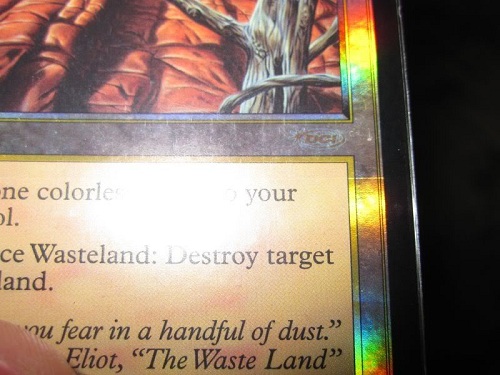
Sometimes, the foil quality on either side of the line is slightly different, too.
While some people have tried to sell these on eBay as valuable misprints, they are actually quite common, especially on promotional cards. The collector community is fairly split on cutlines—half the people don’t care, while the other half believes that it devalues the card to SP or MP.
Personally, I would never discount or devalue a card due to a cutline—too many buyers do not care and will give you full value. However, if you do have one, make sure you disclose it before selling or trading it online—some buyers consider cutlines to be no better than a large crease.
If you have foils in played condition, trading them in person is a much better play than selling or trading them online. Condition degrades the price and desirability of foils quite rapidly—the kinds of people who pay a premium for foils are the same people who care about condition. While this “condition tax” isn’t always reflected in the retail price, it certainly comes up if you actually try to move your cards in a private sale or online trade.
In person, however, I have found that many people will ignore minor condition issues, especially on older or rarer foils. With those cards, you’re probably the only person within 500 miles who has one for trade, so the lack of alternative supply will trump a couple of nicks and dings. In these cases, it can be reasonable to ask for full retail value back in a deal.
This is a very deep topic, and I’m happy to revisit it in the future if people want me to. Otherwise, I’m happy to answer questions in the comment section.
This Week’s Trends
The biggest news of the week is the massive price increase coupled to Magic Online set redemptions. From the program’s inception through Return to Ravnica, it cost just $5 plus $3 shipping to turn an online set into a physical one. From Gatecrash onward, the cost will jump to $25 plus shipping. This is a very big deal.
During Standard season, Magic Online redemption hovers around 2,000 sets per week. (At least, that’s what the Magic Online finance mavens were saying on Twitter this week.) That’s the equivalent of about a million “packs” being opened each month, which is not and insignificant influx of singles.
Dark Ascension sets currently sell (not retail) around $120. Return to Ravnica sets close around $135. The additional $20 fee represents 15-18% of the full value of these sets. If cards on Magic Online keep their current values, set redemption will become a losing proposition instead of a break-even one.
A lot of people have predicted that this will lead to price increases in paper Magic. The massive drop in the price of two to three months after a set comes out has a lot to do with redemptions, after all. Personally, I think this change will hit the online community harder.
Because the online causal community is small and many people use the program exclusively for Limited, online prices tend to be lower than paper prices on all Standard cards except mythic rares. Mythic rares act as the redemption bottleneck—if they were a lot cheaper, people could make all kinds of money buying up sets, redeeming them, and flipping them in paper. Because of redemption demand—you need one of each mythic to complete a set—even bulk mythics are often worth several tickets each.
With the new redemption paradigm, online sets no longer need to be artificially inflated in value by $20 or so in order to hit equilibrium with paper sets. I predict this value will drop right out of the bulk mythics that are worthless except to people attempting to redeem sets. If this happens, redemption can continue on as normal and paper prices won’t go up. If I’m wrong, expect less of a drop-off in Gatecrash prices going forward. We’ll know for sure in a couple of months.
This week has seen massive movement in the price of three Modern cards: Oblivion Stone, Spellskite, and Karn Liberated.
Oblivion Stone is sold out everywhere, and copies have actually started to move at $15, which is kind of absurd. It’s a two-of in a Modern Tron deck and is very good in Commander, but anything over $10 on this is just nuts. If you have any copies lying around, sell them now.
Karn Liberated has hit $40 on StarCityGames.com. I expect it will come back down after Modern season, but I don’t think it’ll drop by all that much. It has value in both casual and competitive Eternal formats, and I’ve been expecting it to jump for months now. $40 is close to a ceiling, so feel free to sell, but there’s no need to dump this like with Oblivion Stone.
Spellskite has hit $12. When I told you to buy at $4 last week, I didn’t expect the spec to pay off quite so soon. I do think the correct price point for this card is around $10, so feel free to get out at $12 if you can. Otherwise, sock them away until next Modern season when they might hit $15-$18.
Birthing Pod hasn’t jumped yet and still might not make its move this season, but if you’re looking for a card with Spellskite-level potential, this is it.
Aurelia’s Fury, Gideon, Champion of Justice, Prime Speaker Zegana, Duskmantle Seer, and Lazav, Dimir Mastermind, are tanking—get out now. Domri Rade, Aurelia, the Warleader, and Obzedat, Ghost Counsel are maintaining their value so far.
Obviously, this section might change depending on the weekend’s results, so check the SCG Standard Open: Edison Top 8 lists before making any decisions on Standard cards.
Until next week–
–Chas Andres
